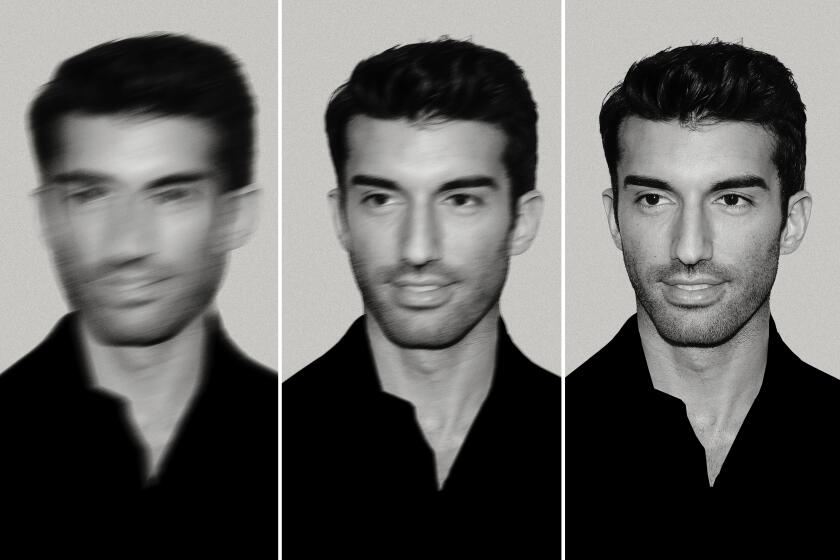A Qualified Thumbs-Up for ‘The Babe’
- Share via
Let it be trumpeted that Hollywood has broken its losing streak, a long one. After a succession of arrogant, in-your-face attempts to cast its actors as legendary baseball heroes, which has been a persistent exercise in chutzpah, a studio now has come close enough to the mark to call for some grateful, unmixed huzzas.
Universal Pictures has brought it off with its new offering, “The Babe,” which happily bears no resemblance, no kinship, with the 1948 issue “The Babe Ruth Story.” That awful thing, an attempt to pass off William Bendix as the Bambino, presented the American public with a two-hour insult on film.
That one was so corny, so schmaltzy that Bob Considine, author of “The Babe Ruth Story,” demanded that his name be left off the movie credits. Ruth himself, present at a screening in the year of his death, said he had seen enough and asked to be hauled away in his wheelchair.
A paramount trouble with that film was the choice of Bendix to personify the Babe. It was a disaster. The relatively short, muffin-faced Bendix was about as believable a Babe as Abe Lincoln. Maybe Hollywood should be forgiven, because more than daunting is the task of coming up with a Babe Ruth look-alike.
Remembered is the splendid observation of Robert Creamer, the best of the Babe Ruth biographers, who said, “for thousands of people, maybe millions, William Bendix in a baseball suit is what Babe Ruth looked like. Which is a terrible shame, because lots of men look like William Bendix, but nobody ever looked like Babe Ruth. Or behaved like him.”
When Hollywood did come up with at least a semi-credible Babe Ruth it found him known less for his movie credits than for his part in a high-rated television sitcom. It was an inspired choice when Universal tapped John Goodman, Roseanne’s TV husband. Goodman qualified in other respects besides the scope of his girth, a recognizable Babe Ruth characteristic.
Possibly it was his adventures with Roseanne that fitted him to personify the quirky behavior of the Babe, but Goodman brought more than that to the film. He exhibited a feel for the ballpark, and the people, and he swung the bat decently enough if allowances are made; and with that putty stuffed into his nostrils to widen and flatten them he affected a quite acceptable resemblance.
“The Babe” tells the Ruth story better than ever before on film, dealing cleverly with his boyhood in that Baltimore industrial school where as a baseball prodigy he started hitting those home runs at the age of 7. And his emergence as an American hero, and his outrageous womanizing that Goodman portrayed like, should we say, an old pro. And never did a reckless roue retain such lovability as the Babe, and Goodman.
There were technical flaws. Goodman didn’t quite get the Ruth home-run gait down pat, those mincing steps around the bases. Later when they purported to show some jealousy toward Babe’s upcoming young home-run rival, Lou Gehrig, the choice of a Lou Gehrig was abysmal. The broad, muscular Gehrig a tall, skinny Bill Dickey type? Sad.
They did catch that called-shot homer off Charlie Root in Wrigley Field in the 1932 World Series when Babe ostensibly pointed to center field and warned Root what was going to happen to his next pitch. Did Ruth actually call that shot? My research says that only one of the hundred-odd baseball writers made mention of any such thing in their next-day stories. And years later in the South Pacific it was Lt. Cmdr. Bill Dickey who said to me “Why spoil a good myth?”
“The Babe” is a relief from what Hollywood offered in its previous efforts to portray the life of the game’s greats. One of those attempts was “The Pride of the Yankees,” in which Hollywood attempted to foist Gary Cooper on us as Lou Gehrig. Gary Cooper as Lou Gehrig? A tall, lanky, small-moving, soft-talking Cooper as the husky, big-shouldered power plant Gehrig? High insolence. And he couldn’t swing a bat either.
They had tried with U.S. president-to-be Ronald Reagan in the protagonist’s role in the Grover Cleveland Alexander bio, “The Winning Team.” Reagan the athlete was adequate, but the story and the romance were too gooey and finally qualified as pure cornball.
More to Read
Only good movies
Get the Indie Focus newsletter, Mark Olsen's weekly guide to the world of cinema.
You may occasionally receive promotional content from the Los Angeles Times.










